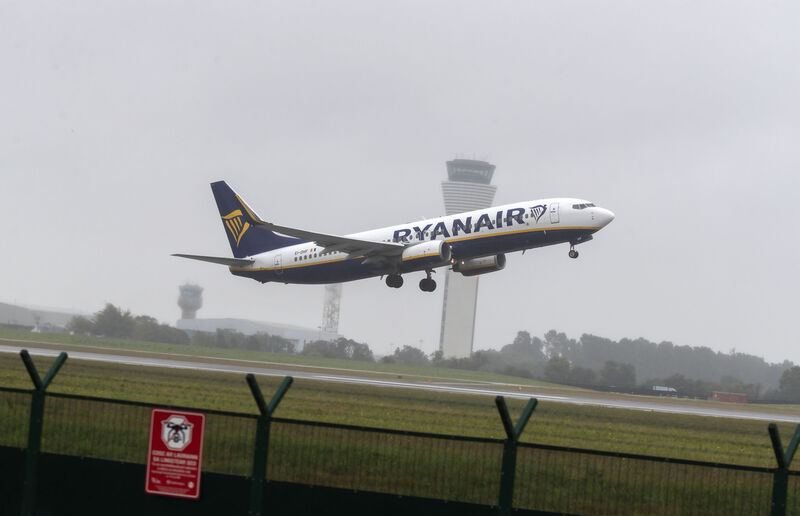'It’s like going from living in heaven to hell': Residents furious over noise from overhead jets

As soon as planes began taking off from the new north runway at Dublin Airport last August, local residents knew they had a serious problem. Picture Colin Keegan/ Collins
Driving back to Dublin after four hours in the leafy environs of The Ward in North Dublin, some 12km from Dublin Airport as the crow flies, a strange thing happens.
I’m driving on the N2, and I notice I can persistently hear the sound of engines. Not your usual dull motorway drone, but the screech of an airliner.
It fades the closer I get back to the city, but the impression has been made. And that’s after four hours. The thought of living with the sound as a constant companion is not a pleasant one.
Yet that is what the residents of Ashbourne and much of the surrounding area are currently being subjected to.
On August 24, 2022, the nearby airport’s new north runway officially opened for business, 15 years after first being given the green light by An Bord Pleanála, over the protests of the board’s own planning inspector.
Immediately, resident Dr Niamh Maher tells the she and her husband knew there was a very serious problem. The house they had built in a quiet rural idyll, in which to live and raise their children, was suddenly being thundered over continuously by jet after jet after jet.

Nearby, Grainne McDermott had a similar experience. She and her husband have lived in the house they built for the past 18 years. They have raised their three children there. Grainne’s mother lives next door.
That morning, she returned from the school run to find her husband standing in the garden.
“You won’t believe what’s been going on here all morning,” he told her.
The majority of the residents of this particular rural area on the Meath-Dublin border are in a similar position. They have built a house in an area that has the hard-to-capture combination of country ambience and access to local amenities. Quiet but far from dull.
All of those the spoke to had obtained planning from Fingal County Council to build their homes from scratch. In some zones close to Dublin Airport, homes need to be assessed in terms of the noise pollution they may have to deal with from incoming and outgoing flight traffic.
None of those homes near Coolquay had required such assessments. Why would they? Planes were never supposed to fly over the area.
Some 31 conditions were imposed by An Bord Pleanála upon granting permission for the construction of the north runway in 2007. The current issues with flight paths and nighttime flights hinge for the most part on five of those conditions.
Condition five, which relates to nighttime flights at the airport, mandated that once the new runway was opened, only 65 flights could enter or leave the airport between the hours of 11pm and 7am each night. This is currently subject to an enforcement order by the local authority, Fingal County Council.
The airport authority, Daa, has applied for a judicial review of that decision. That review will not be heard before November 2023.
Four other conditions are also under investigation, however, and these, particularly condition 1, are fundamental to the issues which have affected local residents since the runway opened.
It states that the development of the runway would be “carried out in accordance with the plans and particulars and the Environmental Impact Statement lodged with the application”.
That statement had considered the noise impact of planes taking off from the runway in a pattern mirroring those seen on the existing south runway but in reverse, that is, flying straight for five nautical miles before any turns are made (that same approach is reiterated most recently in a compliance document regarding noise insulation schemes with regard to the runway operated by DAA and signed off on by Fingal in 2016).
Instead, the day the new runway opened, departing flights began turning right immediately over the nearby residential areas of St Margaret’s and Coolquay.
Daa initially apologised for the imposition, and queried the Irish Aviation Authority, which had approved the flight paths or Standard Instrument Departures (SIDS), as they are known technically, as to how the “challenge” presented by the fact that “a significant number of aircraft are overflying areas not indicated in... communications material issued publicly” could be overcome.
A number of new SIDS became officially operational in February this year, but the core issue, that of aircraft turning immediately upon take-off, remained unresolved.
In some ways, the matter has boiled down to a blame bunfight between Daa and the Irish Aviation Authority, with the latter arguing it is their job only to approve the safety or otherwise of presented flight plans, not to dictate them.
However, the fact remains that people living locally who had made the area their base with a view to peaceful rural living are now having, in the words of one resident, their “lives ruined” by constant aircraft noise.
As Sinn Féin’s transport spokesperson, and local TD for Meath East, Darren O’Rourke told the Oireachtas transport committee in January, the issue appears to be “an unmerciful cock-up” on someone’s part.

His colleague on the committee, Duncan Smith of Labour, summarised things succinctly at the same meeting: “Everyone is just throwing their hands up in the air and asking how anyone could possibly plan a runway that cost so much and had so much public consultation and then, on the morning of the first flights going out, no one knew that the first flights were going to take a right turn in the way they did.”
Daa's official position at present is that flight paths are not subject to planning permission. It will be interesting to see if that approach holds water in the future.
Why the flight paths have evolved the way they have is a question without a defined answer. Residents are in different minds — some think it’s the airport trying to maximise flight numbers by reducing the time between takeoffs.
Others think it relates to ‘go around’ risk — referring to the chance of a plane taking off colliding with another plane which has aborted a landing on the south runway at the same time.
The Irish Aviation Authority lent credence to that theory at its appearance before the Oireachtas Transport Committee in May when chief executive Declan Fitzpatrick noted where parallel runways were in operation, the course of landing and departing aircraft “shall diverge by at least 30 degrees as soon as practicable”.
A Daa spokesperson said that, since 2007, new aircraft “are up to 50% quieter” and that Dublin Airport has "some of the youngest aircraft in Europe, which significantly reduces noise impacts”.
None of that explains why residents were not informed the flight paths were to change — be it days, months or years — in advance.
Daa said the paths introduced in February “align more closely with the information previously communicated by DAA”.
At present, one thing is certain — the locals are absolutely furious, and it’s not hard to see why.
On the morning of my visit, which by all accounts was relatively quiet in terms of flight activity, the noise and frequency of the overflying planes was striking, to say the very least.
Listening back to the recordings of interviews taken that morning, I can’t help but notice every 90 seconds or so the low drone of an approaching airliner turning to a screech as it passes overhead at low altitude.
Niamh Maher is an obstetrician at both the Coombe and Midland Hospital in Portlaoise. She built her home at Coolquay with her husband, also a doctor, in 2019 as the place where they would raise their two children.
Their profession demands they are used to certain levels of sleep deprivation. But not in their home, which of the three we visited is probably the worst affected by the noise, and that is saying something.
“Awful. It’s just awful,” she says.
“You don’t really want to go outside because it just heightens it. And the kids want to get outside and run around, and they’re over there about 10ft away and you’re telling them to be careful or whatever and a plane comes over the hills and they can’t even hear you. And the enjoyment of your garden is gone.
Can it be lived with?
"No. No, not with this level of noise,” she says.
One of the recurring themes you see in visiting each resident’s home is their admission that people have suggested to them that because they built near an airport, they should maybe "learn to live with it".
It is something that causes Niamh Maher to bridle.
“I’m sorry now, everyone here is an intelligent person. We did investigate what was meant to happen before we invested in our home, and to have that choice taken away from you is completely unacceptable,” she says.
“It beggars belief, it’s just ridiculous, but it’s also devastating. We had moved to this area and had done the appropriate investigation. It’s not that we missed something. In our planning application, there was never a hint of anything to do with excessive noise, and that would imply that, unfortunately, the county council weren’t aware of this either.”
Fingal County Council confirmed that since the opening of the north runway, it has received "numerous complaints in relation to alleged breaches of conditions of the planning permission."
"On foot of these complaints, one statutory Planning Enforcement Notice has been issued and several Planning Enforcement investigations are ongoing into compliance with the North Runway planning permission," a spokesperson said.
"Until these processes are concluded, the Planning Authority is unable to comment further on the operation of Dublin Airport."
Breffni Conaty lives nearby with his wife and three children in a house built on land adjacent to his parents’ house.
Their home is bright and cheerful, much like the couple themselves. But the same feeling of frustration permeates everything they have to say about the flights issue.
Mr Conaty says he will no longer allow his children to cycle on the local roads, as the noise from above makes cars impossible to hear.
“This place is a hidden gem,” he says of the area where he built his home in 2017. But he’s unequivocal.
“If my parents weren’t beside us, we’d sell. God knows what valuation we’d get on our house now, but we’d be gone. Because you don’t want to expose your kids to that,” he says.
Cavan native Grainne McFadden, meanwhile, is the outlier of the three in that she has lived in her house, with her husband and family, since before the runway was even applied for. Seventeen years of rural quiet until August 2022.
She is unapologetically emotional about the impact the planes have had on her and her family.
“You’re consumed by anger. You can’t get away from it. You go to your clothesline and it’s there. You go into Ashbourne and it’s there. And I’m getting angrier. It’s such an injustice,” she says.
“I’m used to quiet, that’s how I want to live my life. We built this house without even a contractor. Our blood and sweat is in it. It is memories, it is a home, and now there is nowhere to escape. It’s like going from living in heaven to hell.”
She shows me the copious notes she has taken, as a means to channel her anger, detailing the flights that have passed overhead, together with their altitudes. Some 328 flights in 24 hours on July 20. They average one every two minutes that morning.
The situation has turned such amateur sleuthing into the norm among the residents. Breffni Conaty mentions he and his wife can tell the difference between each plane purely by sound (“The long-haul ones are the easiest, because they’re so much louder”).
All three are of one mind. They don’t want compensation. They want the planes to go away. All believe it’s a fight worth having.
“We want them to obey their own planning. And we’d like to know why they won’t,” says Mr Conaty.
“We want them to do what they said they would,” says Niamh Maher.
All are uniformly scathing about Daa’s level of engagement since the issue raised its head.
“To say they are engaging is an absolute joke,” Niamh Maher says.
A Daa spokesperson said that since 2016 it has “met over 2,000 local residents, either individually or in groups, and has held more than 20 public events”.
“Since 2017, there have been 45 meetings with the St Margaret’s Community Liaison Group and 27 with the Dublin Airport Environmental Working Group,” they said.
“There are meetings but nothing ever results from them,” counters Niamh Maher.
She is similarly deeply unimpressed with the fact noise complaints are to be directed to DAA themselves (the authority recently informed complainants that all complaints received between August 2022 and February 2023 will not be responded to due to the sheer volume of them).
“I find that crazy in the context of my own work, that a complaint (she has sent hundreds via Daa’s complaint portal — “it’s arduous but you’re very motivated”) is sent to the offender for them to decide whether or not it is valid. Because obviously there isn’t proper objectivity there.”
For her, the planning issue is a simple one: “If I didn’t obey planning permission when building my house, they could take my home from me.”
For most residents, trust of Daa went out the window when its former chief executive Catherine Gubbins went before the Transport Committee in January and said she was as surprised as anyone when the runway’s flight paths went awry from last August, only for the IAA to subsequently tell the same committee that May that details of the SIDs had been published two months in advance, and therefore “everyone in the world involved in aviation knew exactly with the SIDS were going to be on the first day of operation."
The IAA declined to comment.
“It completely discredited what they said,” says Niamh.
“We don’t trust anything they say. They deny everything, they are only accountable to themselves.”
Daa meanwhile, has said most recently it is “not appropriate” for it to “further discuss matters which are the subject of ongoing statutory planning enforcement and appeals processes”.
More generally, a spokesperson for the authority said Fingal “is by far the greatest beneficiary of jobs and economic activity associated with Dublin Airport”.
“Although the number of homes close to airport operations is extremely low by international comparison, Daa recognises this does not lessen noise impacts for its closest neighbours,” they said.
What happens next is unclear. For now, the flights continue as they have been and residents do their best to live with it.
The problem isn’t likely to go away though. These locals are unlikely to give up the homes they were used to without a fight.












